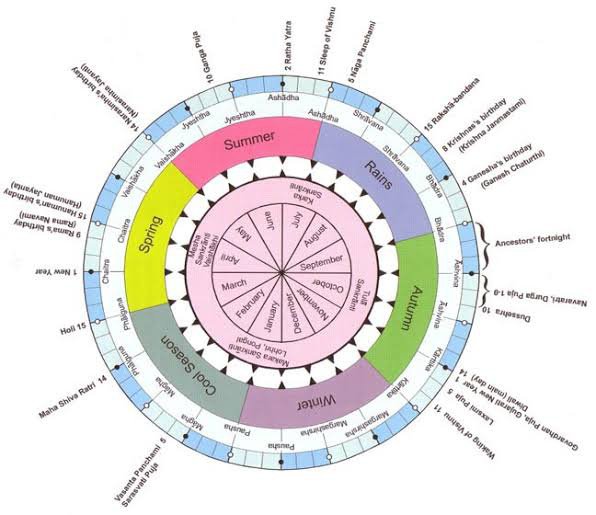The Hindu calendar, also known as the Panchanga or Panchang, is a unique system of timekeeping that holds deep cultural and religious significance in Hinduism. Unlike the Gregorian calendar used in most parts of the world, the Hindu calendar follows a lunar-solar system, incorporating celestial movements and astrology. In this article, we will explore the fundamentals of the Hindu calendar, its various components, and its role in shaping the rich tapestry of Hindu culture and festivals.
1. The Lunar-Solar Nature of the Hindu Calendar
The Hindu calendar is a lunisolar calendar, which means it takes into account both lunar cycles and solar movements. It is based on the positions of the Sun and the Moon, making it more aligned with natural astronomical events.
2. The Components of the Hindu Calendar 2.1 Solar Days – Vaara
he Hindu week consists of seven solar days, each named after a planet: Sunday (Ravivara), Monday (Somavara), Tuesday (Mangalavara), Wednesday (Budhavara), Thursday (Guruvara), Friday (Shukravara), and Saturday (Shanivara).
2.2 Lunar Days – Tithi
Tithi refers to the lunar day and is one of the fundamental components of the Hindu calendar. It is calculated based on the angular distance between the Sun and the Moon.
2.3 Lunar Months – Maasa
The lunar month, known as Maasa, is determined by the Moon’s position concerning the Sun. Each Maasa is either 29 or 30 days long.
2.4 Lunar Constellations – Nakshatra
The Nakshatras are 27 lunar constellations, each associated with specific attributes and characteristics. The Moon’s position in one of these Nakshatras is essential in determining auspicious times and events.
2.5 Solar Months – Ritu/Maasa
The solar months, also called Ritu or Maasa, are determined by the Sun’s movement concerning the zodiac signs. There are 12 Ritus in a year, each associated with a particular zodiac sign.
3. The Hindu Calendar in Practice
3.1 Determining Festivals and Auspicious Days
Hindus follow the Panchanga to plan religious festivals, ceremonies, and other important events. The alignment of Tithi, Nakshatra, and Vaara plays a crucial role in deciding auspicious timings.
3.2 Celebrating Seasons and Harvests
The Hindu calendar also marks various agricultural festivals that celebrate the changing seasons and the bountiful harvests.
4. Adaptations in Different Regions
Different regions within India and across the Hindu diaspora may use variations of the Hindu calendar based on local customs and cultural influences.
5. Preserving Tradition in Modern Times
Despite the prevalence of the Gregorian calendar, the Hindu calendar remains an integral part of daily life for many Hindus. Traditional Panchangas are still published, and digital versions are easily accessible for modern convenience.
Conclusion
The Hindu calendar, a unique amalgamation of lunar and solar systems, is more than just a method of timekeeping. It is a cultural treasure that guides religious observances, festival celebrations, and auspicious events in the lives of millions of Hindus. By embracing the wisdom of celestial movements and astrology, the Hindu calendar continues to connect people with their cultural heritage and the natural rhythms of the universe.


